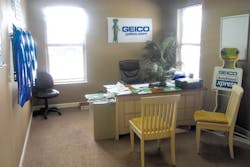The first five years of business were bumpy for True Quality Collision, which opened its doors in 2002. The two-shop start-up company had zero name recognition, no insurance relationships, and barely made ends meet month after month. The struggling company nearly ran into the ground before it ever gained any momentum.
“We were just a start-up company; two little struggling stores,” CEO John Kallenberger says. “There was very little awareness about us, and it was challenging to build our name.”
Something had to change for the shop to stay afloat.
“We needed to land [direct repair] insurance contracts to get more people in the door and have opportunities to sell ourselves,” Kallenberger says.
In a final effort to stay in business, Kallenberger recognized a trend. He says several insurance companies started consolidating their regional claims offices, causing an increased number of adjusters to work out of their homes or cars. Many of those displaced adjusters didn’t have a comfortable space to conduct their daily work.
—John Kellenberger, CEO, True Quality Collision
Kallenberger thought that providing them with a workspace inside his facility would add a higher level of service for insurers, and make his shop more appealing and trustworthy. He figured that providing a quiet place to conduct business and client conversations would ultimately become a driver of insurance referrals.
He did just that in 2007, and it worked. Kallenberger not only landed three direct repair contracts with large insurance carriers, but each of those three insurance companies now have their own full-fledged offices within Kallenberger’s facilities, with adjusters working there full time. He’s currently in negotiations with a fourth insurance company.
“[The office space] was the main reason why we landed each of those in-house contracts. It was a huge selling point,” Kallenberger says. “The business has exploded. We went from two struggling facilities that were ready to go under five years ago to 11 facilities with 100 employees.”
Designing the Office
Adding an office for insurance adjusters is not difficult. Here are a few basic elements to consider:
Placement: Kallenberger says the offices should be placed next to the shop’s waiting room to allow for easy access.
Visibility: Design the office with a window so insurers can easily monitor traffic coming into the facility.
Enclosure: The offices should be fully enclosed so insurance representatives can hold private meetings. It should function as their own private office, and they should be the only people who have access to the space during business hours. Kallenberger even offers a private entrance from outside directly into the office.
Meeting space: Though not mandatory, Kallenberger’s office design also includes a conference room and training room where insurers can conduct large group meetings.
Amenities: The offices should be equipped with basic amenities, including desks, phone lines, an Internet connection, snacks and beverages. You might also consider providing each insurer with designated parking spaces.
Reaping the Benefits
Kallenberger says insurance representatives want to develop long-term relationships with repair facilities that make the repair experience as pleasant as possible—both for them and their clients.
“Everything is based on customer service,” Kallenberger says. “Insurers are looking for shops that can go the extra mile to service everyone involved in the repair at high levels. That’s the most important performance [indicator] in shops today.”
The offering gives insurance adjusters a clean, private place to conduct their duties and interact with claimants. They’re able to stay onsite at the shop for longer periods of time throughout the day, which allows them to more efficiently monitor and assess repair estimates, and make rental arrangements immediately.
Kallenberger says the onsite offices allow each insurance partner to inspect up to 15 jobs a day. He says the office space has led to an average cycle time of 2.9 days on drivable repairs.
“Insurers can do all of their work without coming and going,” he says. “Lots of time is saved by eliminating back-and-forth trips between the shop and their office.”
Kallenberger says the improvements have also prompted insurers to send more work his way. He attributes 90 percent of the company’s growth to the insurance offices he’s built, and he says True Quality Collision receives far more work from his DRPs than other shops in the market that are on their programs.
Today, Kallenberger says his in-house insurance operations generate 70 percent of the company’s annual revenue. One of the company’s locations alone receives 1,000 repairs annually from each insurance partner, and the company has an extensive waiting list of other markets where those partners have requested Kallenberger to build new locations.
“Just being on an insurance program doesn’t always generate a ton of referrals. You have to be at the top of their lists, and customer service is the main element to get you there,” Kallenberger says. “This is how the industry is starting to formulate itself. This is what all insurers are looking for, and the type of shop they prefer to work with. Any shop with a DRP model really needs to have these office amenities; I won’t build any new facility without these operations inside.”
All Insurers Welcome
Even if insurance partners don’t decide to work onsite full time like they do at True Quality Collision, adding office space for adjusters is still a beneficial venture for all shop operations.
Ronnie Johnston, co-owner of Westside Collision in Texas, offers workspace to all insurance representatives—DRP and non-DRP alike. He says the simple effort has benefitted customers, insurance adjusters and the shop in the following ways:
Customer benefit: Johnston says every customer demands and expects high levels of service.
That’s not possible if you force them to conduct insurance conversations in the middle of the lobby where other distractions exist. Providing them with a designated, private space makes customers perceive that they are the most important person in the shop at that time.
Johnston says it also helps to put the customer’s mind at ease. Having the office shows a strong relationship and commitment between the shop and insurance company. Customers feel more comfortable knowing that the shop has had previous associations with their carrier.
“It improves the overall experience, which creates a wow factor and higher satisfaction scores,” Johnston says.
Insurer benefit: Without office space, Johnston says insurers tend to work out of their car in the shop’s parking lot. They’re cramped and have no privacy when customer interactions need to occur.
Ideally, they want a desk to take care of business, and a secluded room to have more personal conversations with clients. Access to an onsite office allows insurers to provide their clients with better service.
Shop benefit: Johnston says the insurance offices have cleaned up his facility because high repair volume can create a lot of congestion in the front office. It got difficult to concentrate on other tasks in the office due to so much simultaneous activity.
It’s critical, Johnston says, to get insurance adjusters away from the front counter to keep noise and clutter to a minimum, so that both the shop and insurer can conduct their conversations and tasks effectively to maintain customer retention rates.
Johnston says the improvement helped develop stronger relationships with adjusters of both DRP and non-DRP companies. They now perceive higher quality and credibility with his business, which has generated trust in his operation and more job referrals.
“Insurers want to keep working with shops that offer amenities that help them do their jobs more efficiently and painlessly for the customer. The more pleasant you can make things for insurers, the more they’ll want to work with you,” Johnston says. “You know you’ve established trust when adjusters send their personal vehicles to your shops. We’ve fixed several.”



